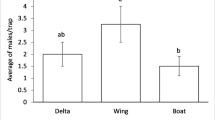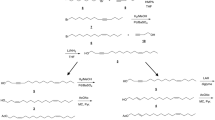Abstract
A binary mixture of (Z)-11-hexadecenal and (Z)-13-octadecenal was first identified as the sex pheromone components of female Chilo suppressalis. Later, an additional component was identified as (Z)-9-hexadecenal, which markedly enhanced the attractiveness to males when it was mixed to the binary mixture. Rubber septa containing ca. 0.3–1.0 mg of a mixture of the above three components in the natural ratio have been shown to keep up significantly higher attractiveness than virgin females for at least one month. It has also been shown that the pheromone trap is much more effective than a light trap, where both traps usually showed similar trap catch patterns. Several factors affecting trap catch, such as trap type, trap placement, etc., have been examined. Feasibility of the population monitoring with the synthetic pheromone was discussed.
Résumé
Un mélange binaire de (Z)-11-hexadecenal et (Z)-13-octadecenal qui a été identifié pour la première fois s’est rèvélé le consituent de la phéromone sexuelle de la femelle de Chilo suppressalis. Par la suite un autre constituent, (Z)-9-hexadecenal a été identifié. Cette substance a remarquablement augmenté l’attractivité vers le maie après avoir été incorporée au mélange binaire. Les septa de gomme contenant ca. 0.3–0.6 mg d’un mélange de ces trois constituents dans un rapport naturel, ont montré une attractivité plus élevée que celle des femelle vierge pendant un minimum d’un mois. Il a aussi été demontré que la trappe pheromonaire était plus effecace que la trappe lumière, où les deux trappes montraient habituellement un effet similaire pour la capture. Nous avons examiné les facteurs qui influencent la trappe de capture, par example le type de trappe, l’endroit où la trappe est placée etc. Nous avons discuté la possibilité de contrôler la population avec les phéromone synthétiques.
Similar content being viewed by others
References
Beevor P. S., Hall D. R., Nesbitt B. F., Dyck V. A., Arida G., Lippold P. C. and Oloumi-Sadeghi H. (1977) Field trials of the synthetic sex pheromones of the striped rice borer, Chilo suppressalis (Walker) (Lepidoptera: Pyralidae) and of related compounds. Bull, entomol. Res. 67, 439–447.
Beevor P. S., and Campion D. C. (1979) The field use of “inhibitory” components of lepidopterous sex pheromones and pheromone mimics. In Chemical Ecology: Odour Communication in Animals (Edited by Ritter F. J.), pp. 313–325. Elsevier/North Holland, Amsterdam.
Beevor P. S., Dyck V. A. and Arida G. S. (1981) Formate pheromone mimics as mating disruptants of the striped rice borer moth, Chilo suppressalis (Walker). In Management of Insect Pests with Semiochemicals (Edited by Mitchell, E. R.), pp. 305–312. Plenum Press, New York.
Kanno H. (1986) Monitoring of the rice stem borer moth, Chilo suppressalis, with the synthetic pheromones (in Japanese only). Nogyo oyobi Engei 61, 1204–1208.
Kanno H., Tatsuki S., Uchiumi K., Kurihara M., Fukami J., Fujimoto Y., and Tatsuno T. (1978) Disruption of sex attraction in the rice stem borer moth, Chilo suppressalis Walker, with components of the sex pheromone and related chemicals. Appl. Entomol. Zool. 13, 321–323.
Kanno H., Hattori M., Sato A., Tatsuki S., Uchiumi K., Kurihara M., Fukami J., Fujimoto Y., and Tatsuno T. (1980) Disruption of sex pheromone communication in the rice stem borer moth, Chilo suppressalis Walker (Lepidoptera: Pyralidae) with sex pheromone components and their analogues. Appl. Entomol. Zool. 15, 465–473.
Kanno H., Hattori M., Sato A., Tatsuki S., Uchiumi K., Kurihara M., Ohguchi Y., and Fukami J. (1982) Release rate and distant effects of evaporators with Z-11-hexadecenal and Z-5-hexadecene on disruption of male orientation in the rice stem borer moth, Chilo suppressalis Walker (Lepidoptera: Pyralidae). Appl. Entomol. Zool. 17, 432–438.
Kanno H., Abe N., Tatsuki S., and Fukami J. (1984a) The active term of the synthetic sex pheromone of the rice stem borer moth, Chilo suppressalis Walker, (Lepidoptera: Pyralidae). Proc. Assoc. Plant Prot. Hokuriku No. 32, 42–43.
Kanno H., Onozuka K., Mizusawa M., Saeki Y., Koike K., Tatsuki S., and Fukami J. (1984b) Comparison of trap efficiency between the synthetic sex pheromone and the light trap in the rice stem borer moth, Chilo suppressalis Walker (Lepidoptera: Pyralidae). Proc. Assoc. Plant Prot. Hokuriku No. 32, 44–46.
Kanno H., Abe N., Mizusawa M., Saeki Y., Koike Kobayashi S., Tatsuki S., and Usui K. (1985) Comparison of the trap efficiency and fluctuation pattern of moth catches between the synthetic sex pheromone and the light-trap in the rice stem borer moth, Chilo suppressalis Walker (Lepidoptera; Pyralidae). Jpn. J. Appl. Entomol. Zool. 29, 137–139.
Lee J. O., Park J. S., Goh H. G., Kim J. H., and Jun J. G. (1981) Field study of mating confusion of synthetic sex pheromone in the striped rice borer, Chilo suppressalis (Lepidoptera: Pyralidae). Kor. J. Plant Prot. 20, 25–30.
Mochida O., Arida G. S., Tatsuki S., and Fukami J. (1984) A field test on a third component of the female sex pheromone of the striped stem borer, Chilo suppressalis, in the Philippines. Entomol. Exp. Appl. 36, 295–296.
Nakano K., Ando T., Koyama S., and Emura K. (1986) Practical use of the synthetic sex pheromone for population monitoring of the rice stem borer moth, Chilo suppressalis Walker. Proc. Assoc. Plant Prot. Hokuriku No. 34, 12–15.
Nesbitt B. F., Beevor P. S., Hall D. R., Lester R. and Dyck V. A. (1975) Identification of the female sex pheromone of the moth, Chilo suppressalis. J. Insect Physiol. 21, 1883–1886.
Ohta K., Tatsuki S., Uchiumi K., Kurihara M. and Fukami J. (1976) Structures of sex pheromone of rice stem borer. Agric. Biol. Chem. 40, 1897–1899.
Song Y. H., Song H. Y., Kim H. K., Chang Y. D. and Lippold P. C. (1978) Studies of the synthetic pheromones of striped rice borer and tortricid insect pests. Kor. J. Plant Prot. 17, 41–47.
Tanaka F., Yabuki S., Tatsuki S., Tsumuki H., Kanno H., Hattori M., Usui K., Kurihara M., Uchiumi K. and Fukami J. (1987) Control effect of communication disruption with synthetic pheromones in paddy fields in the rice stem borer, Chilo suppressalis (Walker) (Lepidoptera: Pyralidae) Jpn. J. Appl. Entomol. Zool. 31, 125–133.
Tatsuki S. (1990) Recent studies on the application of the sex pheromone of the rice stem borer moth, Chilo suppressalis. In Behavior-Modifying Chemicals for Insect Management: Applications of Pheromones and Other Attractants (Edited by Ridgway R. L., Silverstein R. M. and Inscoe M. N.), pp. 387–406. Marcel Dekker Inc., New York.
Tatsuki S., Ohta K., Uchiumi K., Kurihara M. and Fukami J. (1977) Field attractiveness of the synthetic sex pheromone of the rice stem borer, Chilo suppressalis Walker (Lepidoptera: Pyralidae), Botyu-Kagaku 42, 1–3.
Tatsuki S., Kurihara M., Uchiumi K., Fukami J., Fujimoto Y., Tatsuno T. and Kishino K. (1979) Factors improving field trapping of male rice stem borer moth, Chilo suppressalis Walker (Lepidoptra: Pyralidae), by using synthetic sex attractant. Appl. Entomol. Zool. 14, 95–100.
Tatsuki S. and Kanno H. (1981) Disruption of pheromone communication in Chilo suppressalis (Walker). In Management of Insect Pests with Semiochemicals (Edited by Mitchell E. R.), pp. 313–325. Plenum Press, New York.
Tatsuki S., Kurihara M., Usui K., Ohguchi Y., Uchiumi K., Fukami J., Arai K., Yabauki S. and Tanaka F. (1983) Sex pheromone of the rice stem borer, Chilo suppressalis (Walker) (Lepidoptera: Pyralidae): The third component, Z-9-hexadecenal. Appl. Entomol. Zool. 18, 443–446.
Tatsuki S. and Sugie H. (1990) Rice insect pheromone identification and utilization in monitoring. In Experimental Methods in Rice Entomology (Edited by Heinrichs E. A., and Miller T. A.) Springer-Verlag, New York. (In press).
Author information
Authors and Affiliations
Rights and permissions
About this article
Cite this article
Tatsuki, S. Status of Application of Sex Pheromone of Rice stem Borer Moth, Chilo suppressalis in Japan. Int J Trop Insect Sci 11, 807–812 (1990). https://doi.org/10.1017/S1742758400021378
Received:
Revised:
Published:
Issue Date:
DOI: https://doi.org/10.1017/S1742758400021378
Key Words
- Sex pheromone
- rice stem borer
- Chilo suppressalis
- pheromone traps
- population monitoring
- mating disruption




